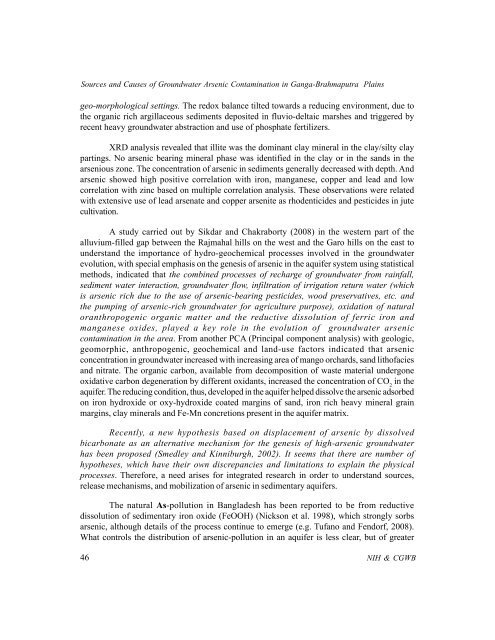Mitigation and Remedy of Groundwater Arsenic Menace in India
Mitigation and Remedy of Groundwater Arsenic Menace in India
Mitigation and Remedy of Groundwater Arsenic Menace in India
You also want an ePaper? Increase the reach of your titles
YUMPU automatically turns print PDFs into web optimized ePapers that Google loves.
Sources <strong>and</strong> Causes <strong>of</strong> <strong>Groundwater</strong> <strong>Arsenic</strong> Contam<strong>in</strong>ation <strong>in</strong> Ganga-Brahmaputra Pla<strong>in</strong>sgeo-morphological sett<strong>in</strong>gs. The redox balance tilted towards a reduc<strong>in</strong>g environment, due tothe organic rich argillaceous sediments deposited <strong>in</strong> fluvio-deltaic marshes <strong>and</strong> triggered byrecent heavy groundwater abstraction <strong>and</strong> use <strong>of</strong> phosphate fertilizers.XRD analysis revealed that illite was the dom<strong>in</strong>ant clay m<strong>in</strong>eral <strong>in</strong> the clay/silty claypart<strong>in</strong>gs. No arsenic bear<strong>in</strong>g m<strong>in</strong>eral phase was identified <strong>in</strong> the clay or <strong>in</strong> the s<strong>and</strong>s <strong>in</strong> thearsenious zone. The concentration <strong>of</strong> arsenic <strong>in</strong> sediments generally decreased with depth. Andarsenic showed high positive correlation with iron, manganese, copper <strong>and</strong> lead <strong>and</strong> lowcorrelation with z<strong>in</strong>c based on multiple correlation analysis. These observations were relatedwith extensive use <strong>of</strong> lead arsenate <strong>and</strong> copper arsenite as rhodenticides <strong>and</strong> pesticides <strong>in</strong> jutecultivation.A study carried out by Sikdar <strong>and</strong> Chakraborty (2008) <strong>in</strong> the western part <strong>of</strong> thealluvium-filled gap between the Rajmahal hills on the west <strong>and</strong> the Garo hills on the east tounderst<strong>and</strong> the importance <strong>of</strong> hydro-geochemical processes <strong>in</strong>volved <strong>in</strong> the groundwaterevolution, with special emphasis on the genesis <strong>of</strong> arsenic <strong>in</strong> the aquifer system us<strong>in</strong>g statisticalmethods, <strong>in</strong>dicated that the comb<strong>in</strong>ed processes <strong>of</strong> recharge <strong>of</strong> groundwater from ra<strong>in</strong>fall,sediment water <strong>in</strong>teraction, groundwater flow, <strong>in</strong>filtration <strong>of</strong> irrigation return water (whichis arsenic rich due to the use <strong>of</strong> arsenic-bear<strong>in</strong>g pesticides, wood preservatives, etc. <strong>and</strong>the pump<strong>in</strong>g <strong>of</strong> arsenic-rich groundwater for agriculture purpose), oxidation <strong>of</strong> naturaloranthropogenic organic matter <strong>and</strong> the reductive dissolution <strong>of</strong> ferric iron <strong>and</strong>manganese oxides, played a key role <strong>in</strong> the evolution <strong>of</strong> groundwater arseniccontam<strong>in</strong>ation <strong>in</strong> the area. From another PCA (Pr<strong>in</strong>cipal component analysis) with geologic,geomorphic, anthropogenic, geochemical <strong>and</strong> l<strong>and</strong>-use factors <strong>in</strong>dicated that arsenicconcentration <strong>in</strong> groundwater <strong>in</strong>creased with <strong>in</strong>creas<strong>in</strong>g area <strong>of</strong> mango orchards, s<strong>and</strong> lith<strong>of</strong>acies<strong>and</strong> nitrate. The organic carbon, available from decomposition <strong>of</strong> waste material undergoneoxidative carbon degeneration by different oxidants, <strong>in</strong>creased the concentration <strong>of</strong> CO 2<strong>in</strong> theaquifer. The reduc<strong>in</strong>g condition, thus, developed <strong>in</strong> the aquifer helped dissolve the arsenic adsorbedon iron hydroxide or oxy-hydroxide coated marg<strong>in</strong>s <strong>of</strong> s<strong>and</strong>, iron rich heavy m<strong>in</strong>eral gra<strong>in</strong>marg<strong>in</strong>s, clay m<strong>in</strong>erals <strong>and</strong> Fe-Mn concretions present <strong>in</strong> the aquifer matrix.Recently, a new hypothesis based on displacement <strong>of</strong> arsenic by dissolvedbicarbonate as an alternative mechanism for the genesis <strong>of</strong> high-arsenic groundwaterhas been proposed (Smedley <strong>and</strong> K<strong>in</strong>niburgh, 2002). It seems that there are number <strong>of</strong>hypotheses, which have their own discrepancies <strong>and</strong> limitations to expla<strong>in</strong> the physicalprocesses. Therefore, a need arises for <strong>in</strong>tegrated research <strong>in</strong> order to underst<strong>and</strong> sources,release mechanisms, <strong>and</strong> mobilization <strong>of</strong> arsenic <strong>in</strong> sedimentary aquifers.The natural As-pollution <strong>in</strong> Bangladesh has been reported to be from reductivedissolution <strong>of</strong> sedimentary iron oxide (FeOOH) (Nickson et al. 1998), which strongly sorbsarsenic, although details <strong>of</strong> the process cont<strong>in</strong>ue to emerge (e.g. Tufano <strong>and</strong> Fendorf, 2008).What controls the distribution <strong>of</strong> arsenic-pollution <strong>in</strong> an aquifer is less clear, but <strong>of</strong> greater46NIH & CGWB




